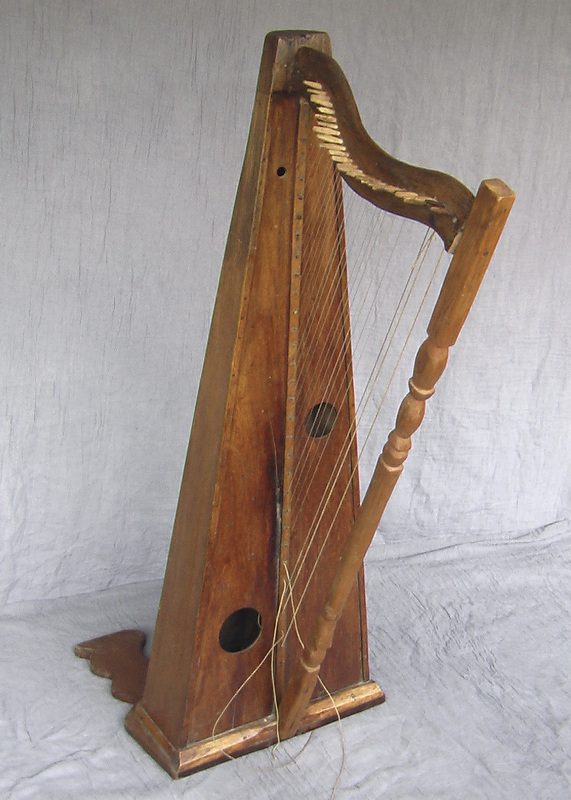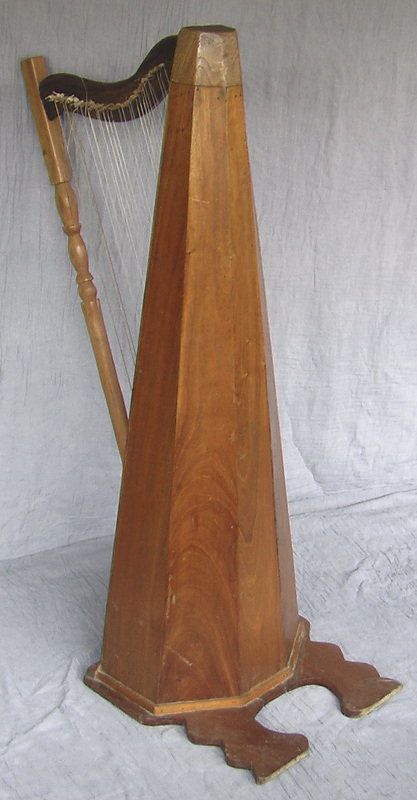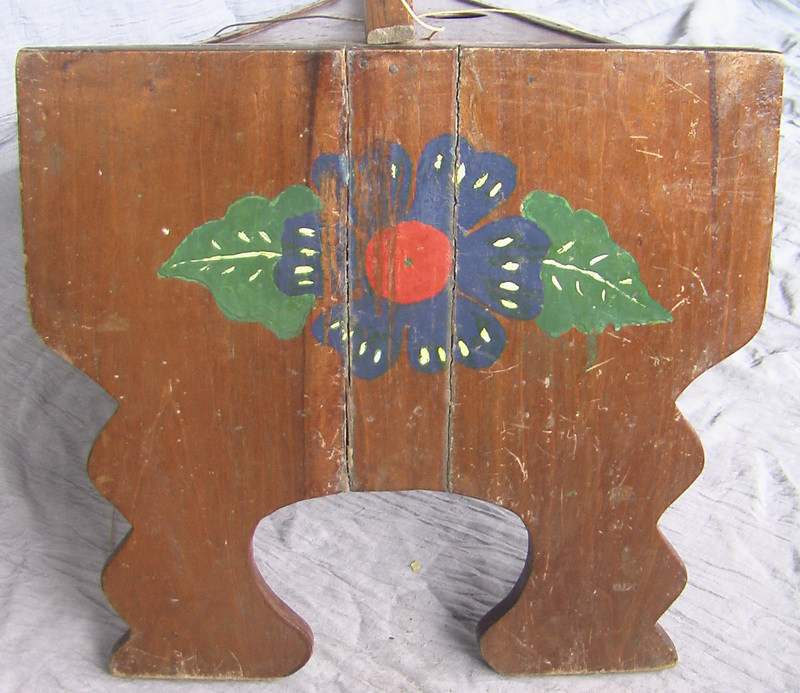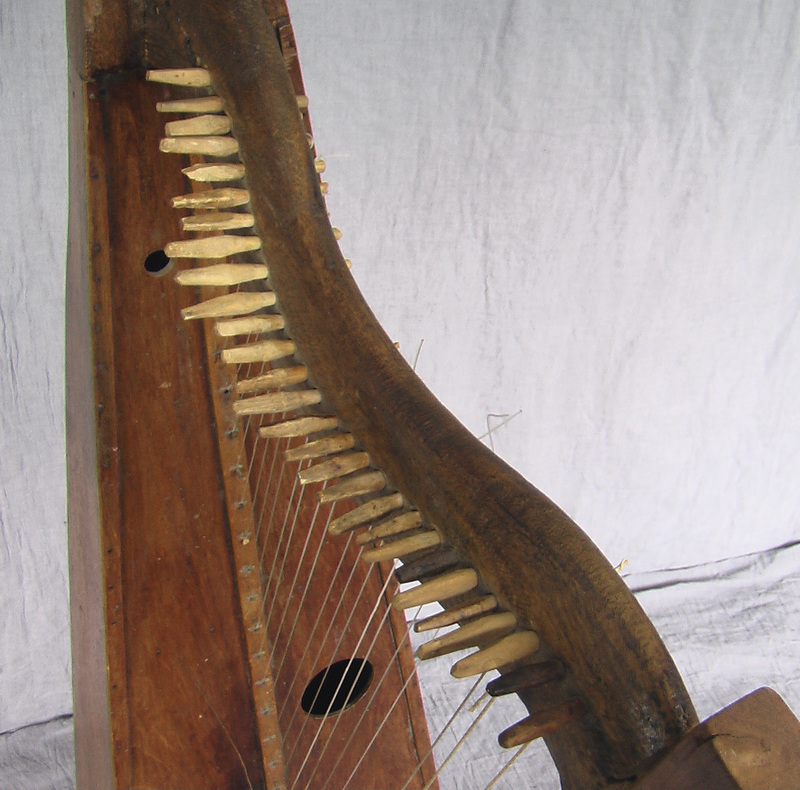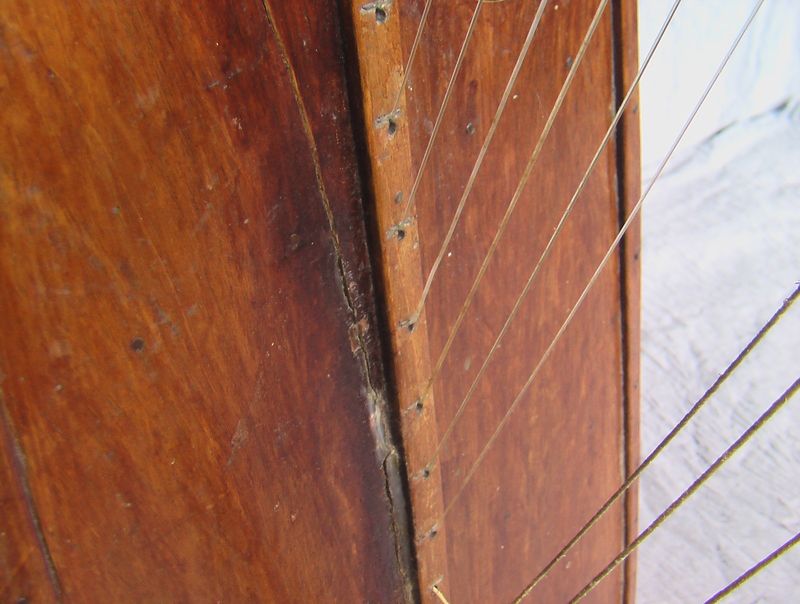Contextual Associations
The ahpareo is a frame harp chordophone of the Yoheme/Yaqui people of Mexico (Sonora State) and the U.S.A. (Arizona). “Ahpareo” is derived from the Spanish “arpa,” a diatonic frame harp introduced to the Yaqui by Spanish Jesuit missionaries in the 17th century. The primary context of performance of the ahpareo in Yaqui communities today is for accompaniment of the Pascola/Pahko’ola dance, which can be performed at any of their religious fiestas any time of year. The ahpareo has, at least in the recent past, also been played outside of ceremonial contexts by Yaqui musicians. The ahpareo pictured and described here was purchased years ago in an Arizona antique shop and subsequently gifted to the Grinnell College instrument collection. Information about its age, place of origin (Arizona or Mexico?), and maker has, unfortunately, not accompanied it.
Description
The triangular-shaped frame of the ahpareo is made entirely of wood (possibly cedar). Its resonator, which forms one side of the frame, consists of several thin boards of wood glued together to form a resonating chamber: one thin, flat board serves as the instrument’s soundboard (gallery #1) and has three circular sound holes in it; five other narrower boards are glued together to form a five-sided resonator box that is narrower at its top than at its base (detail #1). The resonator is closed at its top by a solid block of wood and at its base by a footed board of wood with a plant painted on it (detail #2). The other two sides of the frame are: 1) a post made of wood that is basically rectangular in its profile with two sections that have been rounded on a lathe (gallery #1); and 2) a peg block made from a solid board of wood that has been given a subtle undulating shape (detail #3). Mortice-and-tenon joints are used to connect one end of the peg block to the block of wood at the top of the resonator and its other end to the top of the post. A notch cut in the bottom end of the post rests against the angled edging of the resonator’s base board and is held in place by the tension of the instrument’s strings. While this ahpareo is currently not in playing condition, it once had twenty-eight strings (two of which are now missing and three others broken). The twenty-one highest-pitched strings are made from synthetic line, the seven lowest-pitched strings from gut. One end of each string is wound around a wooden friction tuning peg embedded in the peg block; its other end passes through a hole in the thin reinforcing strips of wood that run down the center of the resonator soundboard, one visible on the exterior of the resonator soundboard (detail #4) and the other on the face of the soundboard in the interior of the resonator. The bottom end of each string is tied to an end-stick which prevents the string from passing back through the soundboard and provides the resistance necessary to tune the string to its desired level of tension using the tuning peg at its other end. A metal staple serving as a nut is pounded into the resonator’s external wood strip just above each of the twenty-three highest-pitched string holes (detail #4); the five lowest-pitched strings have no such nut. Some ahpareo may have more than twenty eight strings; Schechter mentions seeing a photograph of an ahpareo with thirty four strings (p. 200).
Player - Instrument Interface and Sound Production
The musician performing the ahpareo is either seated or kneeling on one knee with the harp tilted back so that only the back edge of the base feet touch the ground; the back of the resonator rests on the musician’s right thigh. The player’s right arm passes under and around the resonator and is positioned to sound the higher-pitched strings with the fingers of the right hand. The player’s left arm is stretched out in front of him and the fingers of the left hand are used to sound the lower-pitched strings of the harp. Either the player’s fingertips or fingernails are used to pluck the strings. The harp is tuned to a diatonic scale. When used to accompany the Pascola/Pahko’ola dance it is heard in combination with one or more violin (audio #1). The ahpareo ”provides both a harmonic accompaniment and at times the melody of pieces and at one point in the middle of the night is played solo without the violins and dancers.” (Haefer p. 59) Audio #2 is an example of the ahpareo being played solo.
Origins/History/Evolution
The arpa was introduced to the Yaqui by Spanish Jesuit missionaries in the late 17th century for liturgical use. As Catholic practices became indigenized over time, the primary context of the ahpareo came to be fiestas on church holy days during which the Pascola/Pahko’ola dance was performed. While the original harps introduced by the Jesuits probably originated in Europe, at some point during the past three-and-a-half centuries they started to be produced by the Yaqui in Mexico. This almost certainly involved changes in the materials of construction, but it doesn’t appear as though many morphological changes have been introduced. One feature of the ahpareo pictured here that seems to set it apart from other diatonic harps in Latin America is the shape of its base board. We have not come across other frame harps in Latin America, or anywhere in the world, with feet that are quite so robust in construction while still being integral with the base of the resonator. Diatonic harps elsewhere in Mexico and in Latin America in general usually have feet made from wooden rods that are attached to the base of the harp.
Bibliographic Citations
Charters, S. B., and Jean Zeiger. 1956. Recording notes accompanying Folkways Records F-6957 release “Yaqui Dances, The Pascola Music of the Yaqui Indians of Northern Mexico.”
Griffith, James S. 1998. "Yaqui and Mayo." In The Garland Encyclopedia of World Music v.2. South America, Mexico, Central America, and the Caribbean. ed. Dale A. Olsen and Daniel E. Sheehy. New York: Garland Publishing, pp. 588-594.
Haefer, J. Richard. 2014. “Ahpareo [aapaleo],” NGDMI v.1:58-59.
Schechter, John M. 1992. The Indispensable Harp. Kent, Ohio: The Kent State University Press.
Spitzer, Nick. 1995. Text from: Program Notes, Folk Masters, reprinted in: "Wood That Sings, Indian Fiddle Music of the Americas." 1997. one CD, Smithsonian Folkways SF 40472, track 15.
Varela-Ruiz, Letcia T. 1982. Die Musik im Leben Yaqui: Beitrag zum Studium der Tradition einer mexikanischen Ethnie. Regensburg: Gustav Bosse Verlag.

